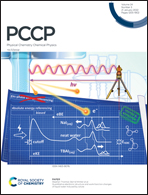Magnetically induced ring currents in metallocenothiaporphyrins†
Abstract
The magnetically induced current–density susceptibility tensor (CDT) of the lowest singlet and triplet states of the metallocenothiaporphyrins, where the metal is V, Cr, Mn, Fe, Co, Ni, Mo, Tc, Ru, or Rh, have been studied with the gauge-including magnetically induced currents (GIMIC) method. The compounds containing V, Mn, Co, Tc or Rh were studied as cations because the neutral molecules have an odd number of electrons. The calculations show that the aromatic nature of most of the studied molecules follows the Hückel and Baird rules of aromaticity. CDT calculations on the high-spin states of the neutral metallocenothiaporphyrins with V, Mn, Co, Tc or Rh also shows that these molecules follow a unified extended Hückel and Baird aromaticity orbital-count rule stating that molecules with an odd number of occupied conjugated valence orbitals are aromatic, whereas molecules with an even number of occupied conjugated orbitals are antiaromatic.



 Please wait while we load your content...
Please wait while we load your content...